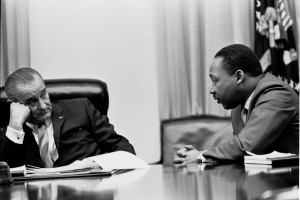 In 1964 I was a high school senior in a small town in Texas. Our lives were filled with studies and parties. Several of us were competing for academic recognition, and local tradition dictated the seniors were feted at a whole series of luncheons and celebrations. But we were still reeling from the assassination of President Kennedy, and all around us, the country was in transition.
In 1964 I was a high school senior in a small town in Texas. Our lives were filled with studies and parties. Several of us were competing for academic recognition, and local tradition dictated the seniors were feted at a whole series of luncheons and celebrations. But we were still reeling from the assassination of President Kennedy, and all around us, the country was in transition.
In our little town, as in towns across the South, schools had been segregated since the end of the Civil War. Schools for the black kids were on the other side of the railroad tracks. Even Hispanic students spent the first three years in separate schools, ostensibly to learn English. There were segregated bathrooms and water fountains, and black moviegoers sat upstairs in the theatre balcony. Despite the Brown v. Board of Education decision ten years earlier, 1964 was the year our school finally integrated.
The rallying cry for segregated schools had always been “separate but equal,” but it didn’t take long for our school administration to see the lie in that. The black kids who transferred into our high school tested several years behind grade level. In response, the school board decided to hold back those who were seniors for an extra year, so they could be better prepared. Although I didn’t know it at the time, that decision would have repercussions for me, as well.
All through Spring of 1964, President Johnson was working on passage of the Civil Rights Act. Johnson had always been popular, but now many white Texans felt betrayed. Still, even among the people in our town who opposed desegregation, there was a feeling of inevitability. Change was here, and more change was coming.
That year I had a job working behind the lunch counter at the local drug store. Several afternoons a week, a cross country bus stopped outside at the corner so passengers could buy refreshments. One afternoon, a young black soldier with a northern accent – not much older than I – walked through the front door and asked me for a Coke. The store fell silent. My boss, the owner, stepped forward and said gently, “Son, we can’t serve you in here. You can go on around to the back door and we’ll take care of you there.” The young man flushed, the anger on his face vying with humiliation. He walked out, and after a moment, the murmur of conversation resumed. There was no sense in the room of hostility, only of social embarrassment, and, I think, compassion that this boy hadn’t known the rules. I felt helpless and devastated.
As aware as we were of the Civil Rights movement, it was the Vietnam War that loomed largest in our futures. For years we’d been told American advisors were needed to help defend South Vietnam against incursions from the Communist north. But in 1964 American deaths jumped from 118 the year before to 206. My boyfriend and several other boys close to us joined the National Guard. Other classmates rushed to enlist in the Air Force or the Navy, to ensure they would have more options than if they waited to be drafted. We were all excited about leaving school and going out into the world on our own, but as we drew closer to graduation, our anxiety increased.
In my family there was no ambiguity around race. All my prior schools had been integrated, and we had always had black friends. The war was a different matter. My father supported it, and that year, I wasn’t sure what to think. I hated the idea of war, but my parents’ social circle also included many European Jews, and I’d grown up believing the U.S. had been wrong when we failed to intervene earlier. If we’d acted, we could have saved people from the camps. Did we have a responsibility to save the South Vietnamese, too?
In the next few years, I learned a lot more about the war. I became much more radicalized, and active in Civil Rights, feminism and the anti-war movement. But in 1964, most of us were still just waking up, taking in the changes and trying to make sense of it all.
